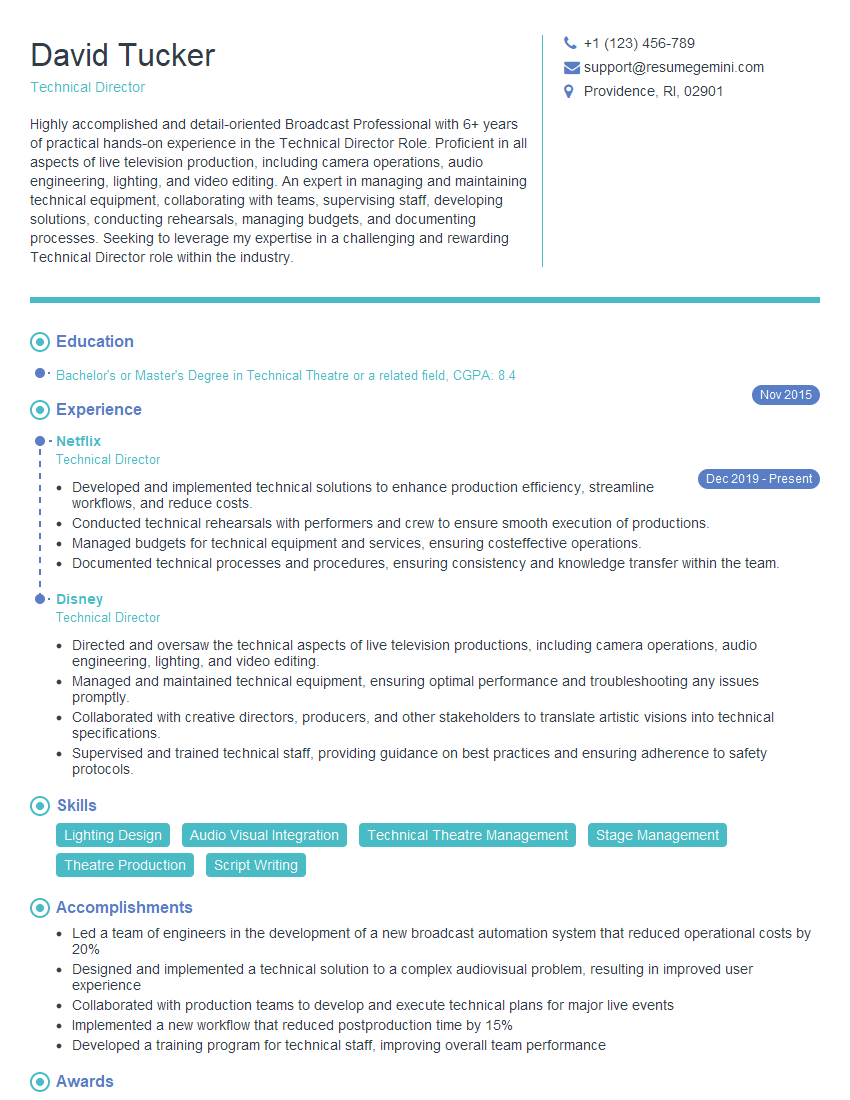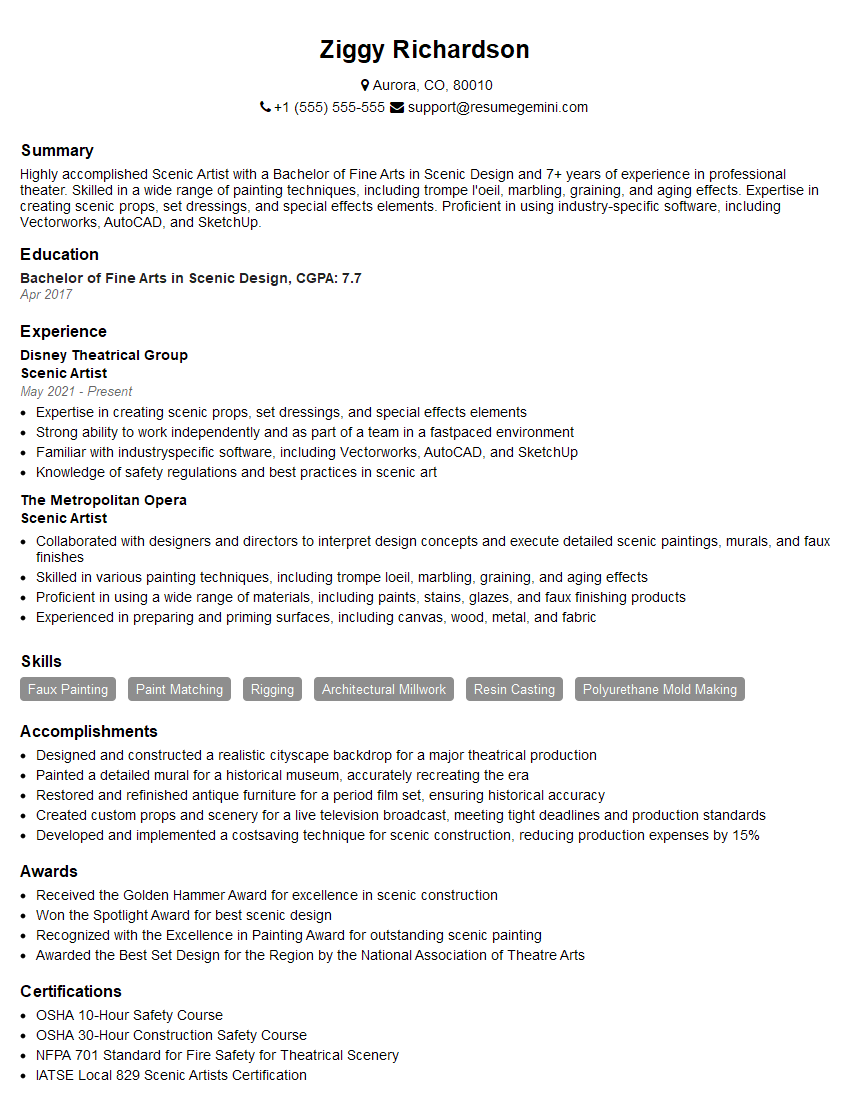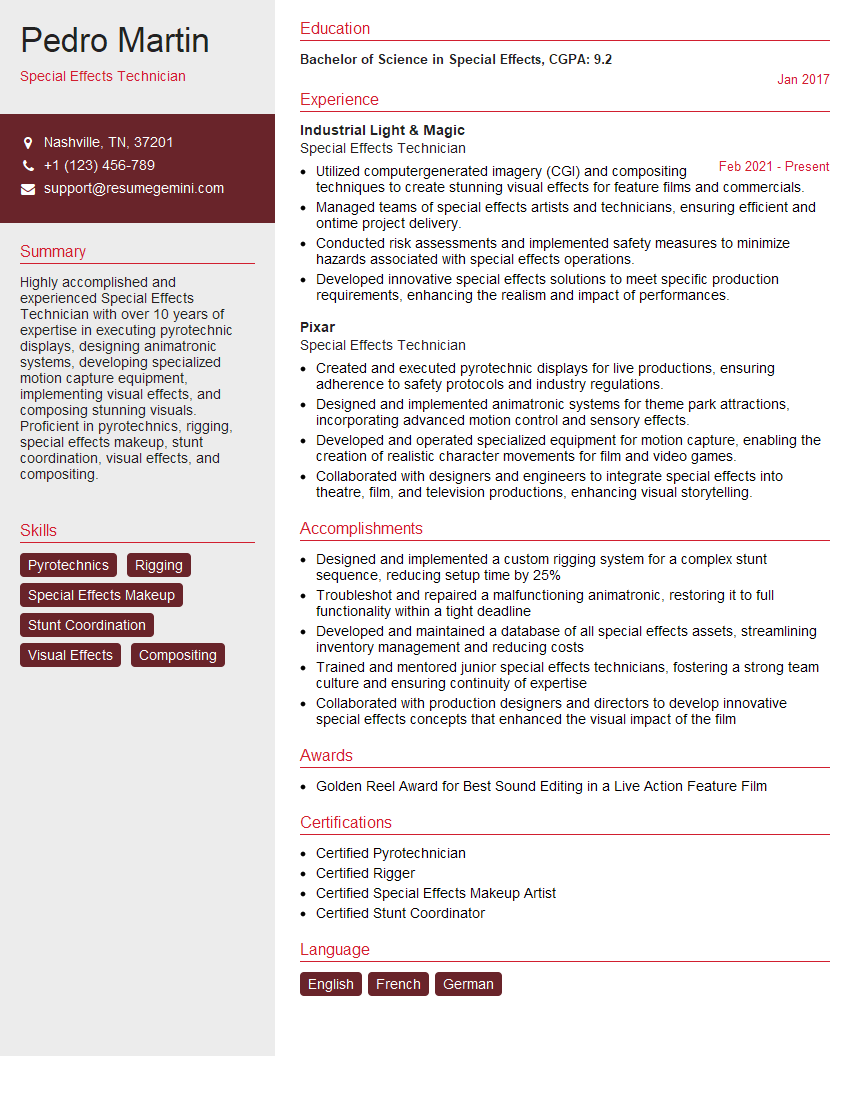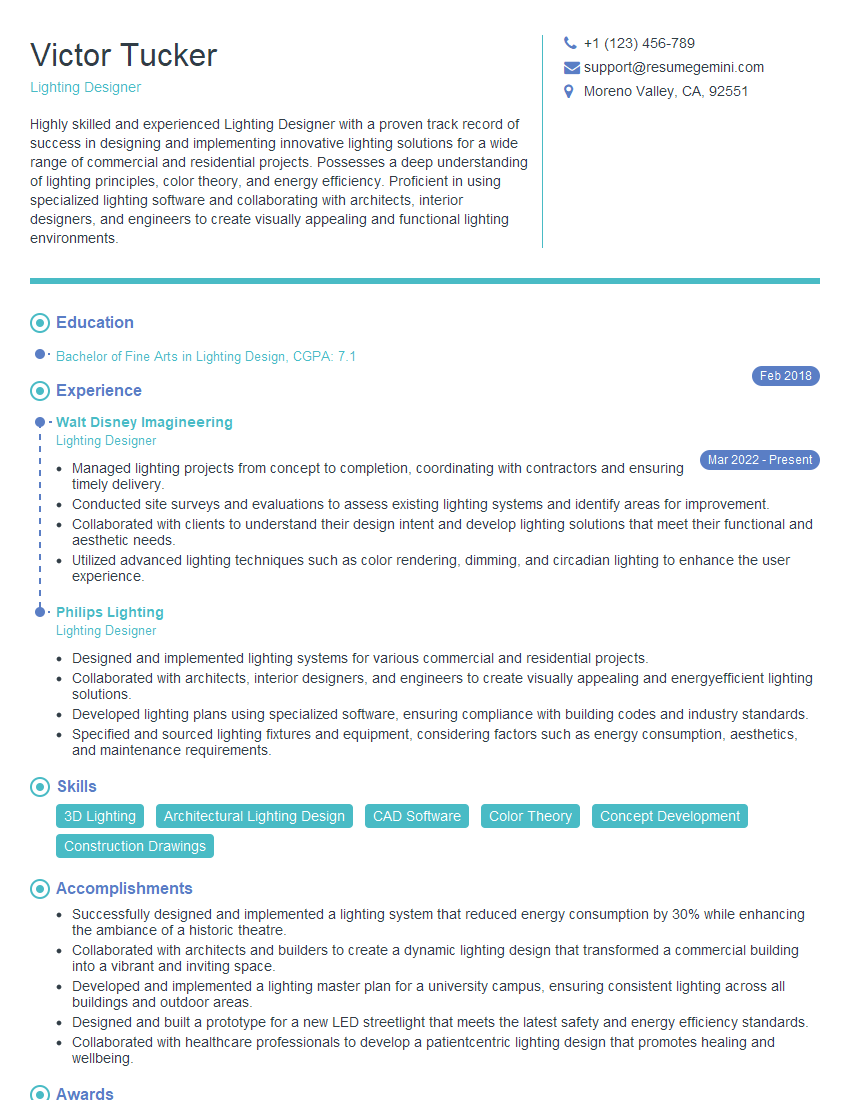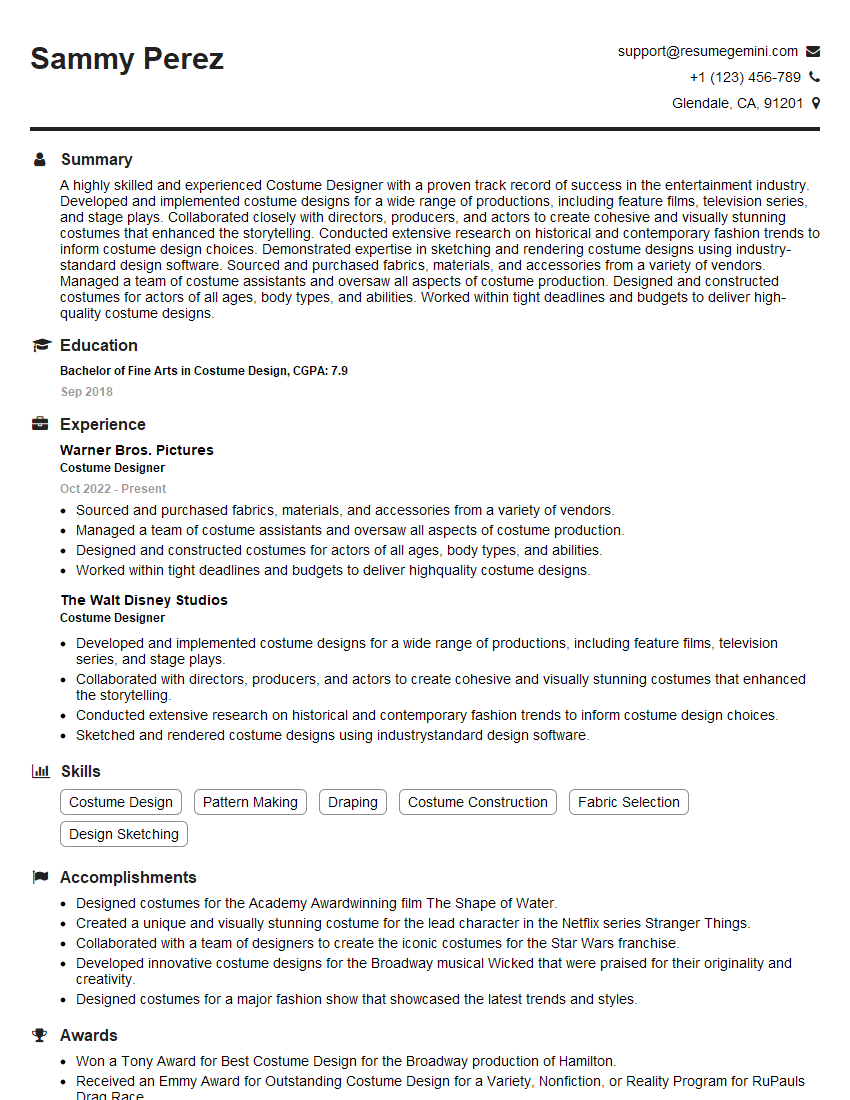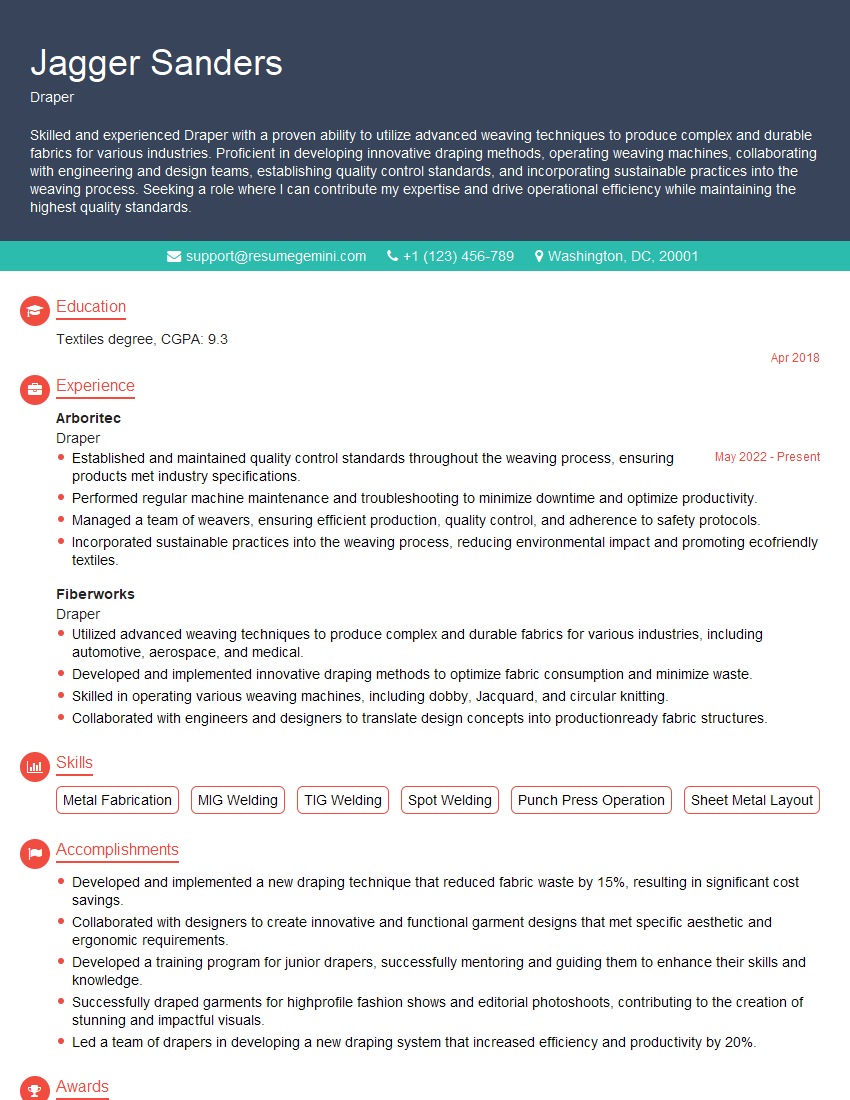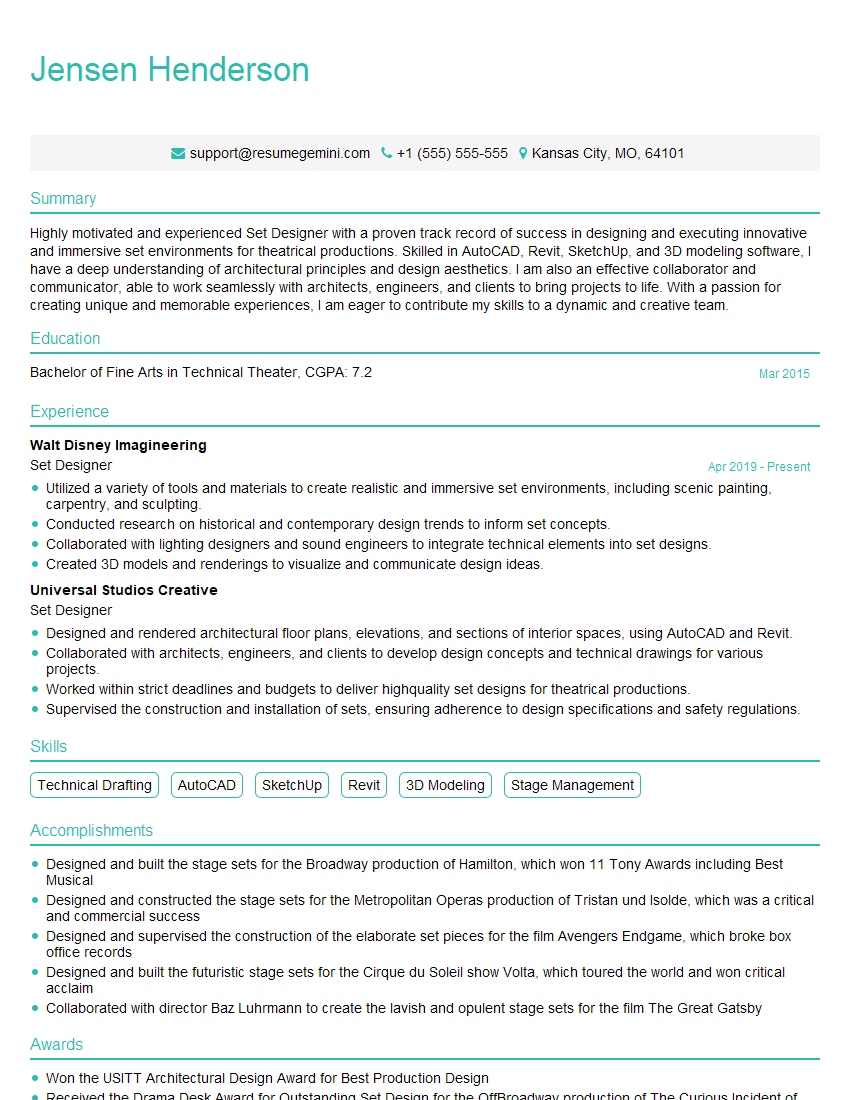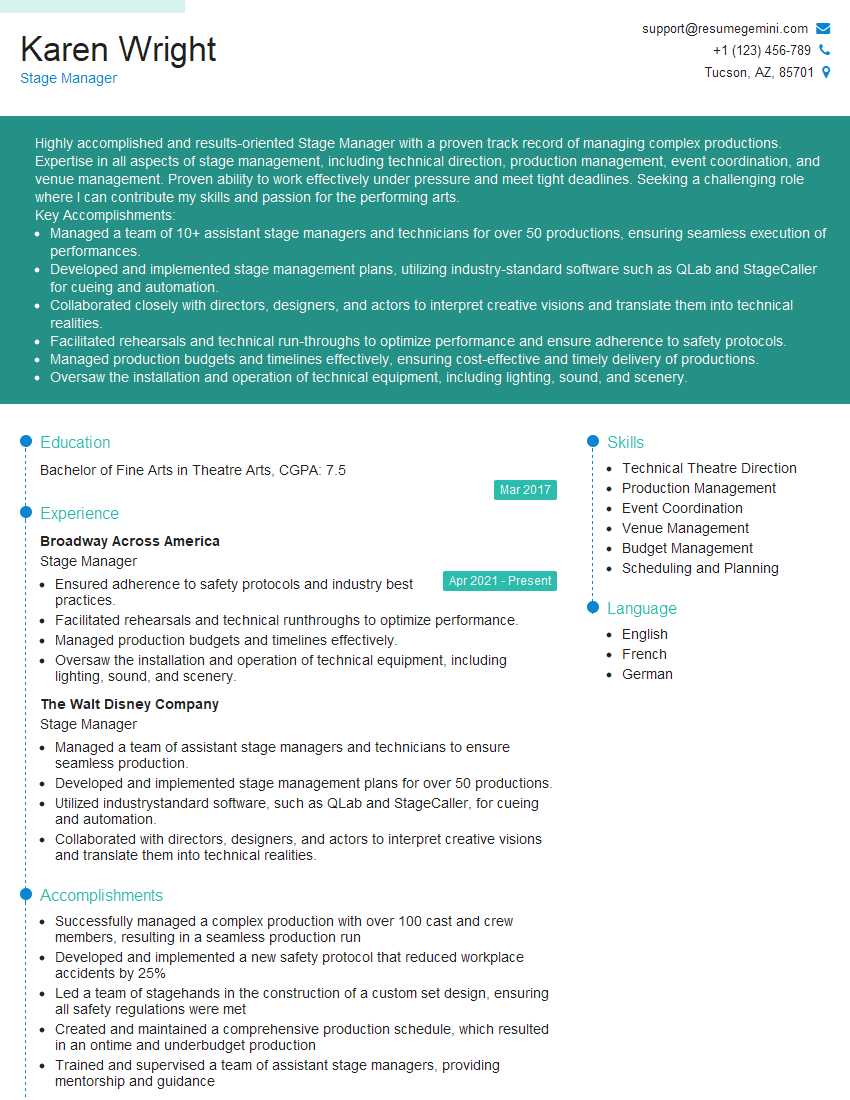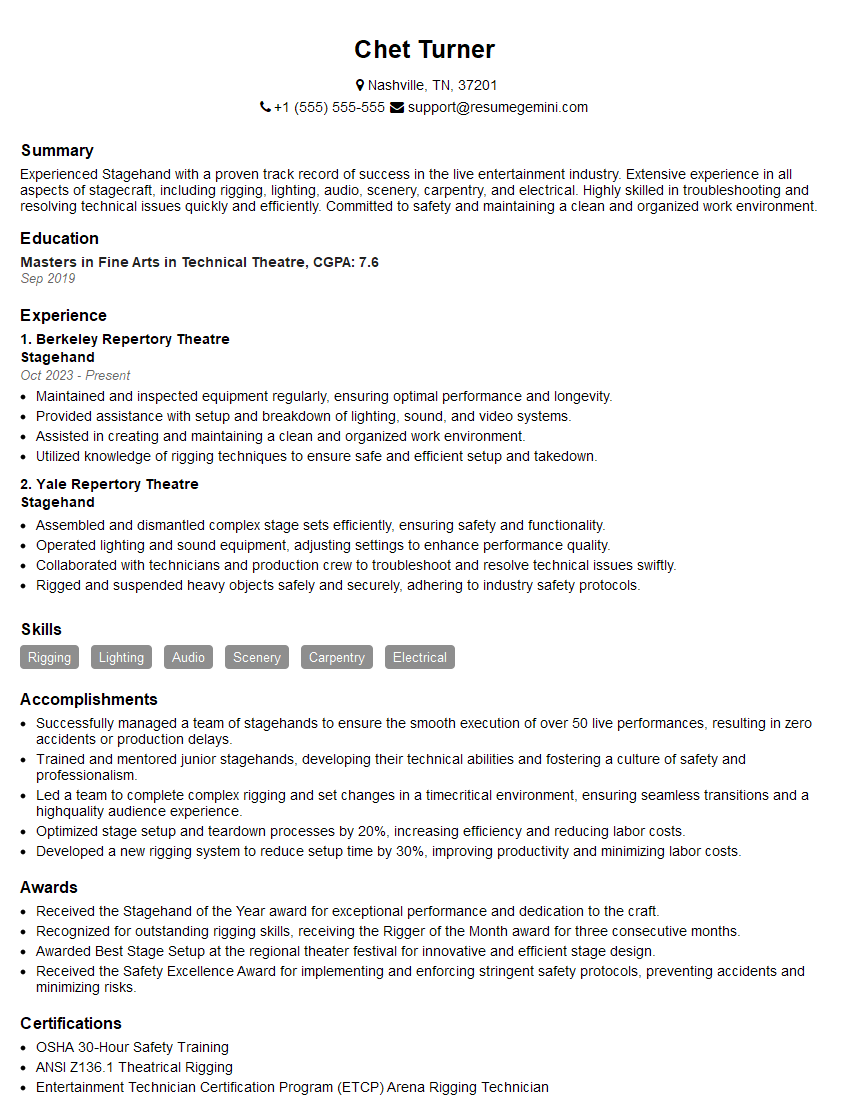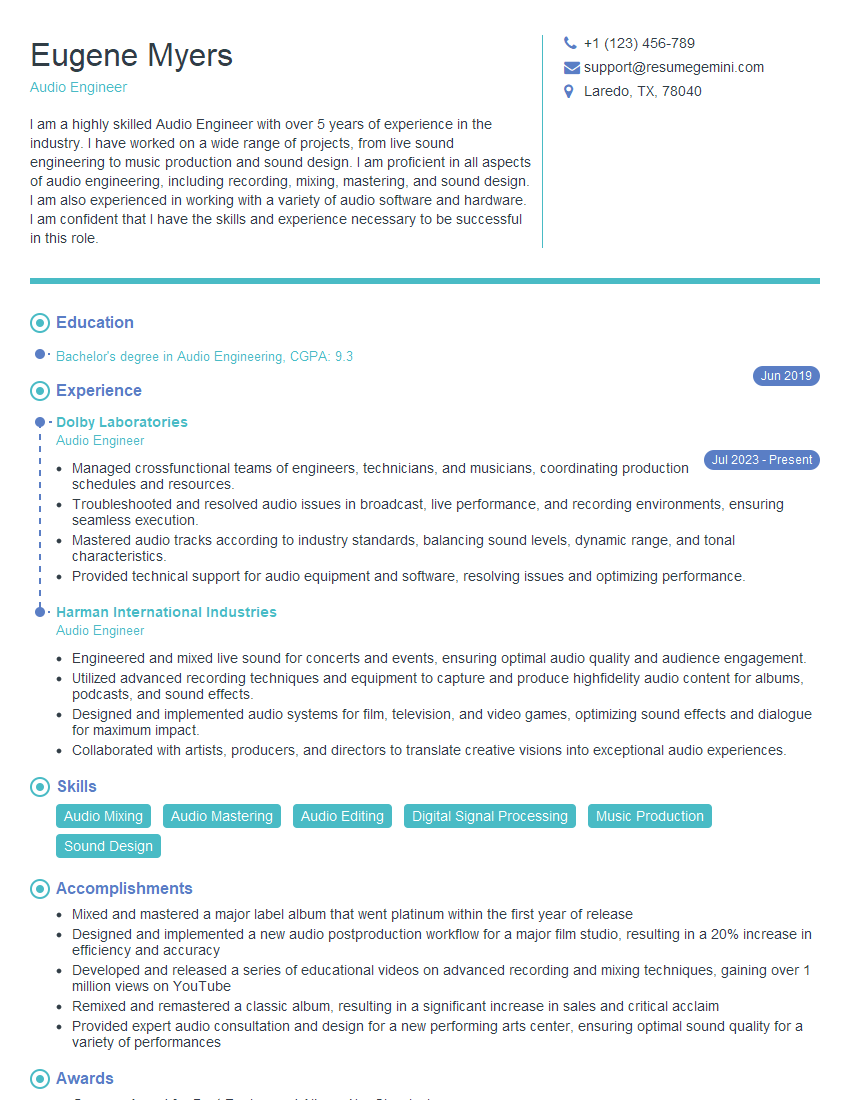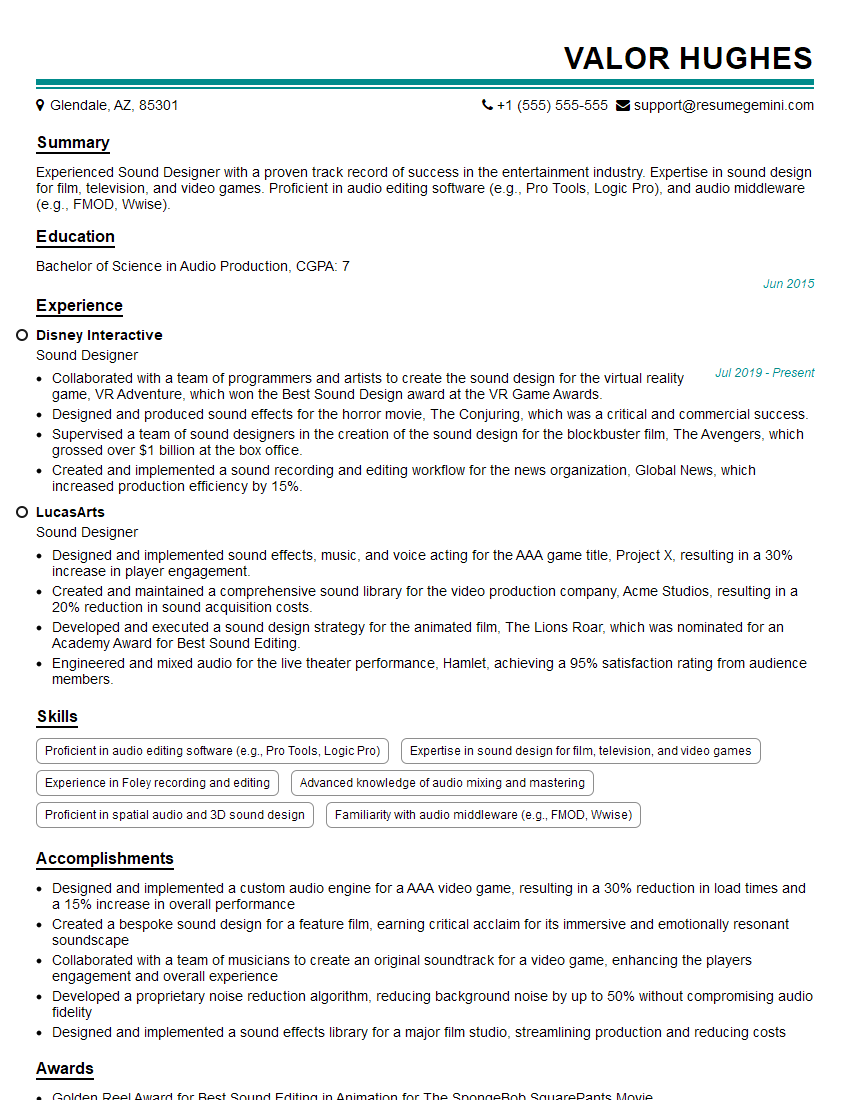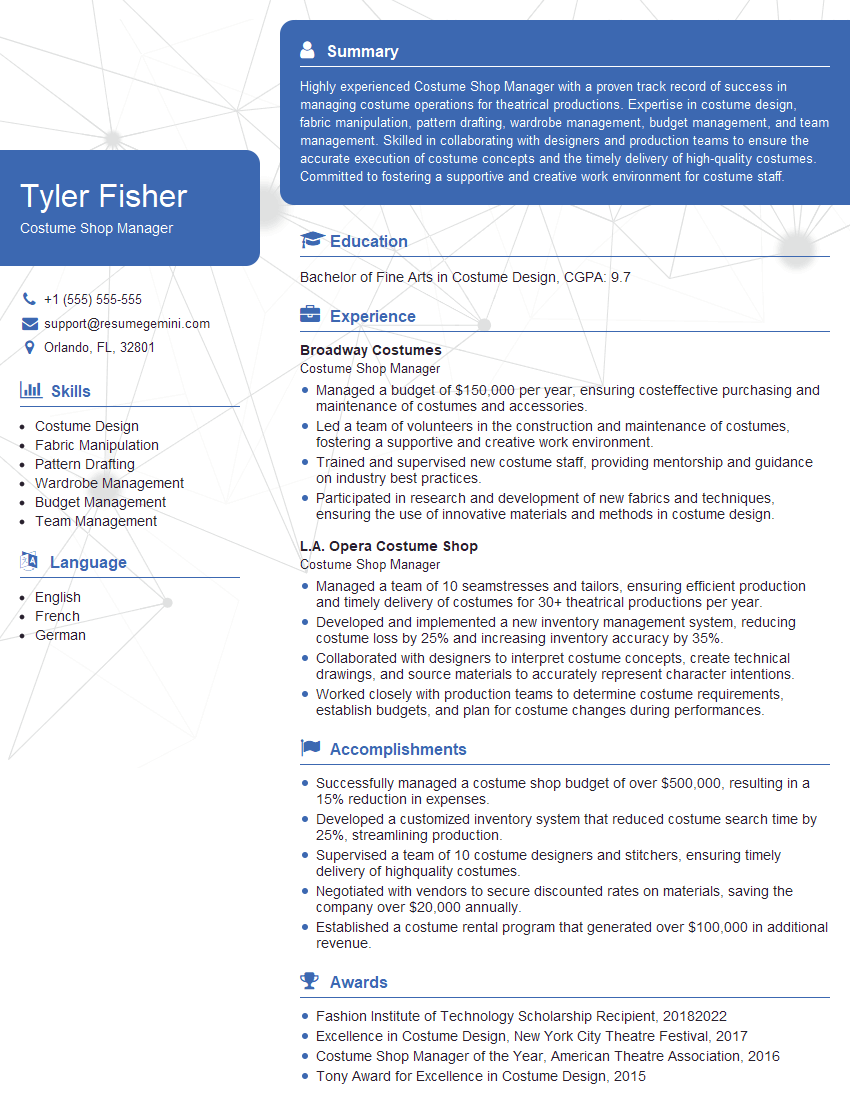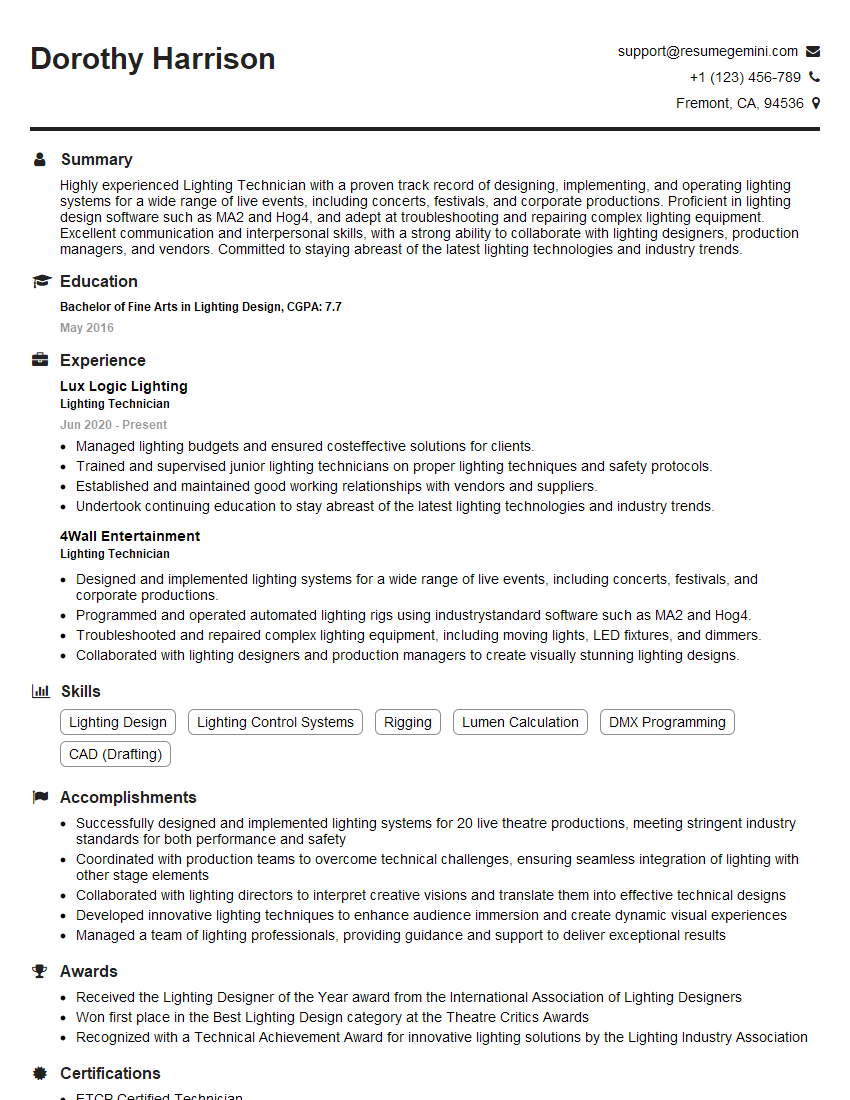Are you ready to stand out in your next interview? Understanding and preparing for Technical Theater and Stagecraft Knowledge interview questions is a game-changer. In this blog, we’ve compiled key questions and expert advice to help you showcase your skills with confidence and precision. Let’s get started on your journey to acing the interview.
Questions Asked in Technical Theater and Stagecraft Knowledge Interview
Q 1. Describe your experience with different types of stage lighting instruments.
My experience with stage lighting instruments spans a wide range, from conventional incandescent and tungsten-halogen fixtures to the latest LED and moving-light technologies. I’m proficient in using Fresnels, which provide a soft, diffused light ideal for washes and backlighting; Ellipsoidals (or Lekos), known for their sharp, controllable beams perfect for highlighting specific actors or objects; PAR cans, offering powerful, focused light, often used for specials or effects; and Cyc lights, designed for even illumination of a backdrop. My experience also includes working with moving lights – automated fixtures offering pan, tilt, gobo, and color-changing capabilities, allowing for dynamic and complex lighting designs. I’ve even worked with specialized instruments like followspots, essential for highlighting solo performers. Each fixture has unique characteristics impacting its application – for example, the color temperature and beam angle of an instrument determine its suitability for a particular scene. Understanding these nuances is key to creating effective lighting designs.
Q 2. Explain the process of creating a lighting plot.
Creating a lighting plot is a meticulous process that starts with a thorough understanding of the script and director’s vision. It’s like creating a blueprint for the lighting design. First, I’ll carefully read the script, identifying key moments and emotional shifts. Then, I’ll consult with the director to understand their artistic intent. The next step involves drafting a visual representation of the stage, including the placement of all set pieces and acting areas. On this layout, I’ll mark the position of each lighting instrument, noting its type, color, and angle. This includes specifying the instrument’s purpose – for instance, front light for illumination, backlight for separation, or side light for shaping. Detailed information, such as dimmer channel assignments, gobo patterns, color filters, and intensity levels, is also documented. This detailed documentation facilitates communication among the lighting team and ensures accurate execution during setup and rehearsals. Think of it as a recipe for the lighting design, enabling the team to accurately reproduce the intended effect.
Q 3. What software are you proficient in for lighting design?
I am proficient in several lighting design software packages, including Vectorworks Spotlight, ETC EOS family (including ETC Nomad), and MA Lighting grandMA2. These software packages provide tools to create detailed lighting plots, program lighting cues, visualize the design in 3D, and control the lighting console during a performance. Each has its strengths and weaknesses; for example, Vectorworks is great for initial design and visualization, while ETC EOS is powerful for programming complex cues and effects. Proficiency in these programs allows me to translate my creative vision into a technically sound and executable lighting design that is easily implemented and managed.
Q 4. How do you troubleshoot a faulty lighting fixture during a performance?
Troubleshooting a faulty lighting fixture during a performance requires a calm, systematic approach. First, I’d identify the problem – is it a complete blackout, a flickering light, a change in color, or something else? Then, I’d check the obvious: is the fixture properly connected? Is the dimmer channel functioning? Are the appropriate circuits switched on? Simple checks often resolve the problem. If the issue persists, I’d consult the lighting plot to determine the circuit and dimmer channel in use. This helps narrow down the source of the fault. If it’s a simple issue like a loose connection, I could resolve it immediately. If it involves a more complex problem with the fixture itself or a faulty dimmer, I’d have a backup strategy ready – a pre-programmed alternate fixture or cue that can smoothly replace the faulty one while repairs are undertaken, minimizing disruption to the performance. Safety is paramount, so I’d ensure that all troubleshooting activities are carried out safely, observing proper electrical procedures.
Q 5. Describe your experience with sound reinforcement systems.
My experience with sound reinforcement systems encompasses all aspects, from microphone selection and placement to speaker system configuration and digital audio workstation (DAW) operation. I’ve worked with various microphone types – dynamic, condenser, lavalier, and boundary microphones – each suited to different applications and sound sources. I understand the importance of microphone placement to minimize feedback and maximize sound quality. My experience also extends to speaker system design, considering factors like speaker placement, equalization (EQ), and delay to ensure even sound coverage throughout the venue. I’m also familiar with digital mixing consoles, where I utilize EQ, compression, and other audio effects to sculpt the sound. Finally, I’m skilled in setting up and operating monitoring systems to ensure performers have adequate sound levels on stage.
Q 6. Explain the principles of acoustic design in a theater.
Acoustic design in a theater is crucial for achieving optimal sound clarity and intelligibility. It involves controlling sound reflections, reverberation, and background noise. The shape and size of the theater greatly influence its acoustics. For instance, a highly reflective surface can cause excessive reverberation, making speech difficult to understand, while strategically placed sound-absorbing materials can reduce this effect. Properly designed sound reflectors can focus sound toward the audience. The placement of sound sources (speakers and microphones) is critical. This is often done with computer modeling for optimum placement before installation. The materials used in construction, such as wall coverings and seating, play a major role in sound absorption and diffusion. Background noise reduction is also crucial. This is done by careful selection of materials, isolation of mechanical equipment, and often the use of sound-dampening insulation. Successful acoustic design ensures that the audience can easily hear the performers regardless of their location in the theater. It’s about creating a balance between live and reflective surfaces, creating a space that is both sonically pleasing and functional.
Q 7. What audio editing software are you familiar with?
I’m proficient in several audio editing software packages, including Audacity (a free and open-source option, great for basic editing), Adobe Audition (a professional-grade DAW with extensive features), and Pro Tools (industry-standard software for professional audio production). These tools allow me to edit and mix audio recordings, apply effects like EQ and compression, remove noise, and prepare sound effects for use in theatrical productions. My skills extend to multitrack recording and mixing, which is essential for creating and manipulating complex soundscapes for performances.
Q 8. How do you manage sound levels and equalization during a live show?
Managing sound levels and equalization during a live show is crucial for a clear and impactful auditory experience. It involves a careful balance of pre-show planning and real-time adjustments. Before the show, we’d use sound design software (like QLab or Ableton Live) to pre-set levels for each microphone, instrument, and sound effect, ensuring nothing is too loud or too quiet relative to others. This involves setting gain staging for each input to avoid clipping (distortion from overloading the signal). During the show, a sound engineer uses a mixing console to make dynamic adjustments. This involves controlling individual channel levels (‘faders’), using equalization (EQ) to shape the frequency response of each sound to improve clarity and reduce muddiness, and employing compression to control dynamic range and prevent sudden loud peaks. For example, we might use a high-pass filter (EQ) on a vocal mic to remove low-frequency rumble, making the voice clearer. If a drum kit is too loud, the engineer might use compression to lower its overall volume while maintaining a dynamic performance.
We also consider the venue’s acoustics. A large, reverberant space needs different sound settings than a smaller, more intimate one. Regular sound checks are vital, and sometimes, we use acoustic treatments (like sound absorbing panels) to improve the sound within the space itself.
Q 9. Describe your experience in set design and construction.
My experience in set design and construction spans over 10 years, encompassing a wide range of projects from small-scale student productions to larger professional theatre shows. I’ve worked on both realistic and abstract sets, employing various materials and construction techniques. For instance, I designed and oversaw the construction of a highly detailed Victorian-era parlor set using a combination of hand-painted flats, detailed molding, and period-appropriate furniture. On another project, we created a more abstract set using repurposed industrial materials like scaffolding and corrugated metal sheets, creating a post-apocalyptic aesthetic. I’m proficient in all phases, from initial concept sketches and drafting to budgeting, sourcing materials, and supervising the construction crew. I value collaboration, and I always work closely with the director, lighting designer, and other technicians to ensure the set seamlessly integrates with the overall production vision.
Q 10. Explain the different types of stage scenery and their construction methods.
Stage scenery encompasses a broad spectrum of elements used to create the visual environment of a play. Common types include:
- Flats: These are essentially large, lightweight frames covered with canvas or hardboard, often painted to represent walls, doors, or other surfaces. Construction involves building a wooden frame and applying the covering. They are often used to create quick changes and flexible scenery.
- Drops: These are large pieces of fabric, often painted, that are hung from the fly system (overhead rigging). They’re commonly used for backdrops and can represent landscapes, skies, or abstract designs. Their construction involves painting onto a strong fabric.
- Platforms: These are raised structures that can provide different levels on stage. They can be simple wooden platforms or more complex structures built for specific needs. Construction involves using sturdy wood and reinforcement.
- Unit Sets: These are modular pieces that can be rearranged to create different settings. Think of individual walls or pieces of furniture that can be combined in different ways.
- Three-Dimensional Scenery: This includes elements that extend beyond the painted flat, like sculpted pieces, furniture, or even functioning machinery. This often requires specialized carpentry, sculpting, or other fabrication techniques.
The construction methods vary depending on the type of scenery, the budget, and the available resources. They often involve carpentry, painting, sewing (for drops), metalwork, and other specialized crafts.
Q 11. What drafting software are you proficient in for set design?
I’m proficient in several drafting software programs, including Vectorworks, AutoCAD, and SketchUp. Vectorworks is my preferred program for set design, due to its powerful features specifically tailored for theater and event design. It allows for precise 2D and 3D modeling, including the ability to create detailed sections, elevations, and renderings. This software also allows for efficient collaboration and communication with other members of the design team. AutoCAD is useful for its precision and compatibility with architectural drawings, and SketchUp excels at creating quick concept models and visualizing ideas.
Q 12. How do you manage the safety aspects of set construction?
Safety is paramount in set construction. My approach involves a multi-layered strategy. Firstly, I ensure all crew members receive thorough safety training before any work begins, covering topics like proper lifting techniques, tool use, and hazard recognition. Secondly, I establish clear safety protocols on the worksite, including the use of appropriate personal protective equipment (PPE), such as safety glasses, gloves, and hard hats. Thirdly, I meticulously plan the construction process to minimize hazards. This involves creating a detailed construction schedule that prioritizes safe working practices and establishes clear lines of communication. For example, we always use proper scaffolding and fall protection when working at heights. Regular inspections are conducted to identify and address potential hazards before they become major issues. Finally, I maintain detailed documentation of all safety measures and incidents. This allows me to continuously improve our safety practices and ensure compliance with all relevant regulations.
Q 13. Describe your experience with costume design and construction.
My experience in costume design and construction is extensive. I’ve worked on numerous productions, designing and creating costumes for actors ranging from classical plays to modern musicals. I begin by researching the historical period, the character’s personality, and the overall aesthetic of the production. This informs my design choices, from fabric selection and color palette to details like embellishments and accessories. I’m adept at various construction techniques, including pattern making, draping, sewing, and millinery. For example, for a recent production of ‘A Midsummer Night’s Dream,’ I created elaborate, whimsical costumes that combined traditional and contemporary elements. This involved hand-sewing intricate details, incorporating natural materials, and dyeing fabrics to achieve specific colors. I strive to collaborate with the actors, understanding their needs and making sure they feel comfortable in their costumes. Fittings and alterations are key parts of the process.
Q 14. Explain the process of creating a costume plot.
A costume plot is a crucial document that outlines every costume needed for a production. It serves as a roadmap for the entire costuming process. It starts with a thorough reading of the script and discussions with the director to understand the character’s roles and the overall aesthetic requirements. Then, we create sketches or renderings for each costume design, detailing the garment type, materials, colors, and special features. The plot then lists each character, the scenes they appear in, and their corresponding costumes. This includes notes on any changes or quick changes needed between scenes. In addition to costume descriptions, the plot typically includes information on accessories, such as hats, shoes, jewelry, and props used with the costumes. Finally, a costume plot will identify any potential problems like quick changes or significant fabric needs for alterations.
For example, if an actor plays multiple roles, the plot will show clearly how the changes are managed and what garments are needed for each role. This detailed document ensures efficient construction, budgeting, and smooth operation during rehearsals and performances.
Q 15. What are some common fabric types used in costume construction?
Choosing the right fabric is crucial in costume construction, as it impacts everything from the look and feel to the durability and performance of a costume. The choice depends heavily on the character, period, and the demands of the play. Some common fabrics include:
- Cotton: A versatile, breathable, and relatively inexpensive option. It’s easy to sew and dye, making it great for many historical and contemporary pieces. Think of a simple peasant blouse or a modern t-shirt.
- Linen: Similar to cotton but with a slightly stiffer drape, linen lends itself well to period costumes and garments that require structure, such as a regency-era dress.
- Silk: A luxurious and flowing fabric, silk creates a beautiful drape and adds elegance to costumes. However, it is more delicate and expensive, typically reserved for more elaborate designs or important characters.
- Wool: A warm and durable fabric that holds its shape well. It’s perfect for outerwear, period costumes (think medieval tunics), or any garment requiring warmth and resilience.
- Velvet: A rich, luxurious fabric with a dense pile. It’s often used for regal or special occasion costumes where texture and visual impact are key. It can be challenging to sew, requiring specialized needles.
- Synthetics (Polyester, Rayon, etc.): These offer a wide range of properties, from wrinkle resistance to stretch. They are often used in conjunction with natural fibers to enhance durability or specific characteristics like stretch in dance costumes.
The choice ultimately depends on a careful consideration of the script’s demands, the desired aesthetic, and the budget.
Career Expert Tips:
- Ace those interviews! Prepare effectively by reviewing the Top 50 Most Common Interview Questions on ResumeGemini.
- Navigate your job search with confidence! Explore a wide range of Career Tips on ResumeGemini. Learn about common challenges and recommendations to overcome them.
- Craft the perfect resume! Master the Art of Resume Writing with ResumeGemini’s guide. Showcase your unique qualifications and achievements effectively.
- Don’t miss out on holiday savings! Build your dream resume with ResumeGemini’s ATS optimized templates.
Q 16. How do you manage alterations and repairs during a production run?
Managing alterations and repairs during a production run requires a proactive and organized approach. Imagine a crucial button falling off during a performance – a quick fix is vital! My strategy involves:
- Pre-emptive Measures: Before the run begins, I conduct thorough inspections of all costumes. This includes checking seams, buttons, zippers, and any other potential weak points. Any minor issues are addressed immediately.
- A Well-Stocked Quick-Fix Kit: I maintain a comprehensive kit containing needles, thread (in various colors), buttons, safety pins, fabric glue, and basic sewing tools. This kit is easily accessible backstage.
- Designated Seamstress/Costumer: Having a dedicated individual (or team) available during performances allows for immediate attention to any issues arising. This person needs strong sewing skills and the ability to work quickly and discreetly.
- Detailed Costume Logs: Maintaining detailed records of each costume, including any pre-existing damage or necessary repairs, is crucial. This allows for efficient tracking of fixes and anticipating potential problems.
- Communication: Open communication with the actors is key. They should report any discomfort or damage to their costumes immediately so that issues can be addressed promptly.
Having a well-organized and prepared system ensures that costume malfunctions are dealt with efficiently and professionally, minimizing disruption to the performance.
Q 17. Describe your experience with props management and creation.
My experience in props management and creation spans diverse projects, from intricate period pieces to contemporary productions. My approach encompasses the entire process, from initial concept to final placement on stage:
- Design & Construction: I collaborate closely with the director and set designer to understand the prop needs of the production. This involves sketching designs, sourcing materials, and meticulously constructing props, ranging from simple items like mugs to elaborate pieces of furniture.
- Sourcing & Acquisition: I’m adept at finding appropriate props, whether through rentals, purchases from prop houses, or even crafting them from scratch using repurposed materials. I’m experienced in identifying cost-effective and creative solutions.
- Organization & Inventory: I implement robust inventory management systems to track each prop, its condition, and its location. This is crucial for efficient organization and preventing loss or damage.
- Maintenance & Repair: Just like costumes, props require regular maintenance. I regularly inspect them for any damage and promptly address any issues to maintain their quality and functionality throughout the production run.
- Stage Placement & Handling: I understand the importance of appropriate stage placement, considering visibility, accessibility, and overall stage flow. I work closely with the stage crew to ensure smooth and safe handling of props during rehearsals and performances.
For example, in a recent production of Shakespeare’s Hamlet, I constructed a highly detailed replica of a skull, using a combination of plaster, resin, and paint, ensuring both realism and durability for handling on stage.
Q 18. Explain the importance of prop safety and handling.
Prop safety is paramount in theatrical productions. Improperly handled props can lead to accidents, injuries, and even production delays. My approach emphasizes:
- Material Safety: Props made of fragile materials (glass, ceramics) must be handled with utmost care. Alternatives like resin or durable plastics should be considered when appropriate. Sharp objects need protective sheathing or padding.
- Safe Construction Practices: During the construction phase, I prioritize safe practices, ensuring that any sharp edges are smoothed, and potentially hazardous elements are mitigated.
- Proper Labeling & Storage: Clearly labeling props indicates their fragility or specific handling requirements. Appropriate storage solutions prevent damage and accidental injury.
- Actor Training: Working with actors to ensure they are properly trained in handling props safely is critical. This includes demonstrating proper techniques and addressing any concerns.
- Regular Inspections: Regular inspections throughout the rehearsal and production phases ensure that props remain in safe condition.
- Emergency Procedures: Having a clear protocol for dealing with accidents or prop malfunctions is essential. This often includes emergency contact information and first aid supplies.
Prioritizing safety not only protects the actors and crew but also ensures a smooth and successful production.
Q 19. How do you source and acquire props for a production?
Sourcing props involves a multi-faceted approach. The process begins with a careful review of the script and design concepts. I then employ the following strategies:
- Prop Houses: Rental from specialized prop houses provides a vast selection of readily available items. This is cost-effective for common props.
- Online Marketplaces: Websites like eBay or specialized theatrical supply sites can be valuable sources for unique or specific items.
- Thrift Stores & Antique Shops: These are excellent places to find unique and characterful items at affordable prices. One can discover surprisingly useful objects.
- Construction from Scratch: If a specific item is unavailable or not feasible to rent, I construct it using appropriate materials and techniques.
- Collaborations & Borrowing: Networking with other theater groups or individuals can lead to collaborative efforts or borrowed items.
- Repurposing & Recycling: Using discarded materials and creatively repurposing them demonstrates sustainable practices and can be cost-effective.
A successful prop acquisition strategy involves considering the budget, time constraints, and the overall artistic vision. Each source is evaluated based on its cost-effectiveness, availability, and appropriateness.
Q 20. What is your experience with rigging and safety procedures?
Rigging, the art of suspending objects from above, requires extensive knowledge of safety procedures and practices. My experience involves both the practical application of rigging techniques and an unwavering commitment to safety protocols.
- Training & Certification: I possess thorough knowledge of weight limits, load calculations, and the safe use of rigging hardware. While specific certifications vary by location, I’m familiar with industry best practices and would obtain necessary licenses for any large-scale project.
- Rigging Inspections: Before any rigging operation, I perform meticulous inspections of all equipment – ropes, cables, pulleys, and other hardware – to ensure they are in top condition and free from damage.
- Load Calculations: Accurate load calculations are paramount. I meticulously calculate the weight of all items to be rigged and ensure that the rigging system can safely support the load. Safety factors are always incorporated.
- Knot Tying & Splicing: Proficiency in various knot-tying and splicing techniques is crucial, ensuring secure and reliable connections.
- Fall Protection Systems: I’m well-versed in the installation and use of appropriate fall protection systems, including harnesses, lanyards, and safety lines.
- Emergency Procedures: In case of any rigging malfunction, I have a comprehensive understanding of emergency procedures, including communication protocols and safe lowering procedures.
Rigging safety isn’t just a procedure; it’s a mindset. It’s about anticipating potential problems and acting proactively to prevent accidents. A single error can have severe consequences.
Q 21. Describe the different types of rigging systems used in theater.
Theater rigging systems vary depending on the scale and complexity of the production. Some common types include:
- Counterweight System: This is the most common system in larger theaters. It uses a counterweight system to balance the weight of the scenery, making it relatively easy to raise and lower. It’s safe and efficient for large, heavy items.
- Hand-Line System: Simpler than a counterweight system, hand-line systems rely on manual operation to raise and lower scenery. They are suitable for smaller venues or productions with lighter items.
- Electric Hoists/Motors: These are used in conjunction with both counterweight and hand-line systems to provide motorized lifting capabilities. They increase speed and precision of movement but require additional safety precautions and maintenance.
- Simple Lifting Systems: For lightweight props or effects, simple rope and pulley systems can be used. These are generally manually operated and require careful attention to weight limits.
- Automated Systems: Larger theatres often incorporate computer-controlled rigging systems that allow for precise, programmed movements of scenery. These systems are highly sophisticated and require specialized training.
Understanding the capabilities and limitations of each system is essential for safe and effective rigging operations. Choosing the right system depends on the scale of the production, the weight of the items being lifted, and available resources.
Q 22. How do you ensure the safety of actors and crew during rigging operations?
Rigging safety is paramount in technical theater. It’s not just about following regulations; it’s about fostering a safety-first culture. We start with meticulous planning and risk assessment. This involves carefully reviewing all rigging plots, ensuring that all load calculations are accurate and conservative, and accounting for any potential environmental factors like wind or temperature.
- Pre-Rig Inspection: Before any rigging operation begins, a thorough inspection of all equipment – ropes, cables, pulleys, shackles, and the load-bearing structure itself – is mandatory. We look for signs of wear, damage, or corrosion. Any questionable equipment is immediately taken out of service.
- Competent Personnel: Only trained and certified riggers should handle rigging operations. This includes knowing knot tying techniques, proper weight distribution, and emergency procedures. We often conduct regular refresher training to ensure everyone stays up-to-date on safety protocols.
- Safety Gear: Hard hats, safety harnesses, and fall protection are always required during rigging. A designated spotter is crucial, especially for complex lifts. They serve as another set of eyes, ensuring a safe and controlled operation.
- Communication: Clear and concise communication is essential. We use standardized hand signals and verbal commands to coordinate lifts. A designated ‘rigger in charge’ ensures everyone understands the plan and follows the procedures.
- Testing and Load Testing: Before a full load is lifted, we conduct a test lift with a weight representing the maximum load or slightly more. This identifies any potential issues before they can cause accidents.
For instance, during a recent production, we discovered a slight fraying in a cable during the pre-rig inspection. Replacing it prevented a potential accident during a crucial scene change.
Q 23. What is your experience with stage automation systems?
My experience with stage automation systems spans over ten years, working with various systems including Chain Motor Hoists, electric winches, and computerized control systems like MA Lighting and Vectorworks. I’ve been involved in the design, installation, programming, and operation of automation systems for a wide range of productions, from large-scale musicals to intimate theater pieces. I’m proficient in troubleshooting malfunctions and performing routine maintenance on these systems. My experience includes working with both simple, individual automated elements and complex, interconnected systems that control multiple elements simultaneously.
In one instance, I integrated a new chain hoist system into an existing fly system. This required careful planning to ensure compatibility and safety, but the result was a more efficient and controlled system for setting and striking scenery.
Q 24. Explain the process of programming and operating stage automation equipment.
Programming and operating stage automation equipment involves a multi-step process. It starts with a careful analysis of the production’s requirements. We create detailed automation plots that specify the movement, speed, and timing of each automated element. This plot often incorporates cues that are synchronized with the lighting, sound, and other stage elements.
- Programming: The automation system is programmed using specialized software. This involves inputting the desired movements for each element, setting limits, defining speeds, and creating cues. The software typically provides visual representations to help verify the programmed movement, often in a 3D environment mirroring the stage.
- Testing and Refining: After programming, we thoroughly test the system. This involves running through all cues to identify any glitches or inaccuracies. The system may require adjustments to ensure smooth and precise movement. This process might involve tweaking timing, acceleration curves or modifying the programmed movements.
- Operation: During performances, the automation is controlled by a designated operator, using either a console or a computer interface. The operator follows the cue sheet, triggering the programmed movements at the appropriate times, monitoring the system’s performance, and reacting to any unforeseen circumstances.
For example, in a recent production, we used a 3D model of the stage in the automation software to program a complex scene change involving multiple automated platforms. This allowed us to visualize and refine the movements before even bringing the equipment to the stage.
Q 25. How do you ensure the safe and reliable operation of automation systems?
Ensuring the safe and reliable operation of automation systems requires a multi-faceted approach. Regular maintenance, safety checks, and thorough documentation are key components.
- Regular Maintenance: This includes routine inspections, lubrication, and replacements of worn parts. We follow the manufacturer’s recommendations for maintenance schedules.
- Safety Checks: Before each performance, a pre-show check of the entire automation system is conducted. This confirms that all elements are functioning correctly and that all safety mechanisms are engaged.
- Emergency Stops and Backup Systems: All automation systems should be equipped with multiple emergency stop mechanisms. Additionally, having a backup system or redundant components helps mitigate the risk of system failures. This could involve separate control systems or mechanically-operated safety mechanisms.
- Documentation: Keeping detailed records of maintenance, repairs, and any modifications is crucial. This helps track the system’s history and allows for efficient troubleshooting in case of problems.
- Operator Training: Operators need thorough training on the operation of the specific automation system. This includes emergency procedures, system limitations, and recognizing potential hazards.
Imagine a situation where a motor starts to overheat during a performance. Our preventative maintenance checks would have likely caught this before it became a critical issue. If not, our emergency stop procedures would be quickly and effectively implemented.
Q 26. Describe your experience with stage management techniques.
My stage management experience encompasses a broad range of productions, including musicals, plays, and dance performances. I’m adept at creating and managing complex cue sheets, coordinating the work of various technical departments, and maintaining clear communication among the entire production team. My experience includes using various stage management software programs to track rehearsals, cues, and maintain detailed communication logs.
In one production, I developed a unique system for tracking props using a barcode system, which significantly streamlined prop management and reduced the risk of errors. This system significantly improved our organization and efficiency.
Q 27. Explain the role of a stage manager in a theatrical production.
The stage manager is the production’s central hub, responsible for coordinating all aspects of the show from rehearsals through the final performance. We’re essentially the glue that holds the entire production together.
- Rehearsal Management: We manage rehearsal schedules, track progress, and ensure that everyone is prepared for each rehearsal. This includes tracking scene changes, blocking, and prop placement.
- Communication: We maintain clear communication with the director, actors, designers, and technical crews. We’re the point person for relaying information and ensuring that everyone is on the same page.
- Cue Management: We create and maintain the show’s cue sheets, ensuring that all technical elements are perfectly timed and coordinated.
- Performance Management: During performances, we call cues, monitor the show’s progress, and handle any unforeseen issues that might arise. We’re the problem-solvers, ensuring the show runs smoothly.
- Paperwork and Organization: A significant part of the job involves meticulous record-keeping. This includes maintaining detailed reports, production schedules, and communication logs.
It’s a demanding role, requiring strong organizational skills, problem-solving abilities, and the ability to remain calm under pressure. But seeing a production come together seamlessly is immensely rewarding.
Q 28. How do you manage multiple tasks and prioritize during a performance?
Managing multiple tasks and prioritizing during a performance requires a highly organized and adaptable approach. The key is proactive planning and utilizing effective communication strategies.
- Prioritization: We prioritize tasks based on their urgency and impact on the show. For example, a sudden lighting failure takes precedence over a minor prop adjustment.
- Anticipation: Experienced stage managers anticipate potential problems. We use this foresight to create contingency plans and proactively address potential issues before they affect the show.
- Delegation: While the stage manager is responsible for the overall production, we effectively delegate tasks to other crew members. This is critical for managing the workload efficiently.
- Communication: During a performance, communication is swift and precise, using headsets and clear, concise language.
- Calmness Under Pressure: Maintaining composure is critical. The stage manager needs to remain calm and efficient even amidst unforeseen circumstances.
Imagine a situation where an actor forgets a prop mid-scene. A well-prepared stage manager would have a backup prop ready and would smoothly and quickly get it to the actor without disrupting the performance.
Key Topics to Learn for Technical Theater and Stagecraft Knowledge Interview
- Stage Lighting: Understanding lighting design principles, including color mixing, instrument selection (e.g., Fresnels, ellipsoidal spotlights), and the practical application of lighting plots and cues.
- Sound Design and Reinforcement: Knowledge of sound systems, microphone techniques, audio mixing consoles, and the process of creating sound effects and integrating music into a production.
- Stage Management and Crew Coordination: Experience with call sheets, run-throughs, communication protocols within a theatrical team, and problem-solving during technical rehearsals.
- Set Construction and Design: Familiarity with drafting, materials, tools, and techniques used in building and assembling sets. Understanding of scenic painting and finishing techniques.
- Costume Design and Construction: Knowledge of fabrics, patterns, sewing techniques, and the process of creating and altering costumes to fit specific characters and productions.
- Rigging and Safety: Understanding of safe rigging practices, weight calculations, and the use of counterweights and other rigging systems. Awareness of relevant safety regulations and protocols.
- Technical Drawing and CAD: Ability to interpret technical drawings, create basic 2D/3D models using CAD software (AutoCAD, Vectorworks, etc.), and communicate design ideas effectively.
- Problem-Solving and Troubleshooting: Demonstrate your ability to identify and resolve technical issues efficiently and creatively under pressure. Describe instances where you successfully overcame challenges during a production.
- Show Control and Automation: Experience with lighting and sound control consoles, automated systems, and the programming and operation of theatrical automation equipment.
Next Steps
Mastering Technical Theater and Stagecraft Knowledge is crucial for career advancement in this dynamic field. A strong understanding of these areas will significantly enhance your job prospects and allow you to contribute effectively to diverse productions. To maximize your chances of landing your dream role, crafting an ATS-friendly resume is paramount. ResumeGemini is a trusted resource to help you build a professional and impactful resume that will stand out to potential employers. We offer examples of resumes specifically tailored to Technical Theater and Stagecraft Knowledge to guide you through the process.
Explore more articles
Users Rating of Our Blogs
Share Your Experience
We value your feedback! Please rate our content and share your thoughts (optional).
What Readers Say About Our Blog
Hello,
We found issues with your domain’s email setup that may be sending your messages to spam or blocking them completely. InboxShield Mini shows you how to fix it in minutes — no tech skills required.
Scan your domain now for details: https://inboxshield-mini.com/
— Adam @ InboxShield Mini
Reply STOP to unsubscribe
Hi, are you owner of interviewgemini.com? What if I told you I could help you find extra time in your schedule, reconnect with leads you didn’t even realize you missed, and bring in more “I want to work with you” conversations, without increasing your ad spend or hiring a full-time employee?
All with a flexible, budget-friendly service that could easily pay for itself. Sounds good?
Would it be nice to jump on a quick 10-minute call so I can show you exactly how we make this work?
Best,
Hapei
Marketing Director
Hey, I know you’re the owner of interviewgemini.com. I’ll be quick.
Fundraising for your business is tough and time-consuming. We make it easier by guaranteeing two private investor meetings each month, for six months. No demos, no pitch events – just direct introductions to active investors matched to your startup.
If youR17;re raising, this could help you build real momentum. Want me to send more info?
Hi, I represent an SEO company that specialises in getting you AI citations and higher rankings on Google. I’d like to offer you a 100% free SEO audit for your website. Would you be interested?
Hi, I represent an SEO company that specialises in getting you AI citations and higher rankings on Google. I’d like to offer you a 100% free SEO audit for your website. Would you be interested?
good

